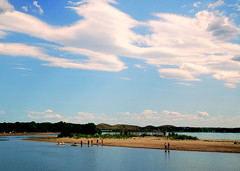 |
| Missouri River (Photo credit: kewing) |
Previously the unit was open to all legal hunting methods in accordance with state and federal codes. Other permitted activities such as hiking, fishing and nature observation will continue outside the immediate closed construction area. The immediate construction area will be closed to all public access for safety reasons until the project is complete. Violation of the closed construction area could result in prosecution. The Lewis and Clark Trail of Discovery will remain open for ¾ mile until it reaches the closed area. Access to the Missouri river from the trail will no longer be possible during the construction period.
During the next year, this refuge unit will undergo habitat improvement to reconnect the Missouri River with its floodplain. The Jameson Island side channel project includes restoration of shallow water habitat through creation of an additional side channel extension on the Missouri River. A contractor for the U.S. Army Corps of Engineers, Kansas City District, will excavate a new side channel approximately one-mile long and link it to an existing side channel constructed in 2006 and 2007. The amount of flow diverted into this side channel from the Missouri River will be less than 10% during the navigation season.
Shallow, slower water provides better habitat for many fishes, in particular the endangered pallid sturgeon.
The U.S. Fish and Wildlife Service is the principal federal agency responsible for conserving, protecting and enhancing fish, wildlife and plants and their habitats for the continuing benefit of the American people. The Service manages the 94-million-acre National Wildlife Refuge System that encompasses more than 560 national wildlife refuges, thousands of small wetlands and other special management areas. It also operates 70 national fish hatcheries, 64 fishery resource offices and 78 ecological services field stations. The agency enforces federal wildlife laws, administers the Endangered Species Act, manages migratory bird populations, restores nationally significant fisheries, conserves and restores wildlife habitat such as wetlands, and helps foreign governments with their conservation efforts. It also oversees the Federal Aid program that distributes hundreds of millions of dollars in excise taxes on fishing and hunting equipment to state fish and wildlife agencies.
The Big Muddy National Fish and Wildlife Refuge encompass over 16,700 acres of public land in eleven separate units in the Missouri River Floodplain between Kansas City and St. Louis. For further information about the Big Muddy National Fish and Wildlife Refuge and to see a map of the updated restrictions visit us on the web at www.fws.gov/refuge/big_muddy/.





No comments:
Post a Comment